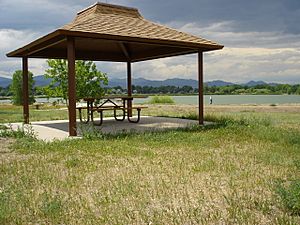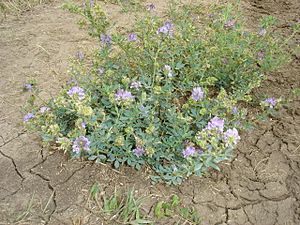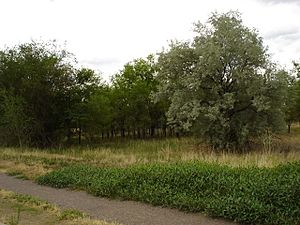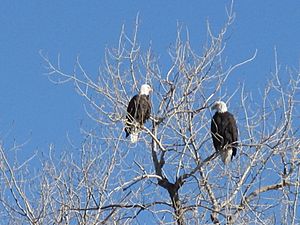Crown Hill Park facts for kids
Crown Hill Park is a fun outdoor area in Jefferson County, Colorado. It's a big park, about 242-acre (0.98 km2), which is like 242 football fields! The park is located between the cities of Wheat Ridge and Lakewood.
Inside the park, there's a special place called a National Urban Wildlife Refuge. This means it's a safe home for many animals and plants right in the city! At Crown Hill Park, you can do lots of cool things like picnicking, hiking, biking, or even riding horses. It's also a great spot for watching wildlife, walking, jogging, and fishing.
Contents
Getting Around the Park
Crown Hill Park is easy to reach because it's close to Denver and has good connections to different ways of travel.
By Bus
You can get to the park using the local bus system called RTD (Regional Transportation District).
- Bus #76 runs along Wadsworth Boulevard, which is about 1-mile (1.6 km) from the park's east side.
- Bus #100 goes along Kipling Parkway, right on the park's west side.
- Bus #28 travels along W 26th Avenue, on the park's south side.
- Bus #32 runs along 32nd Avenue, on the park's north side.
By Car
If you're coming by car, Crown Hill Park is about 2 miles (3.2 km) south of I70 (exit 267) and 2 miles (3.2 km) east of I70 (exit 264). There are two main roads, Kipling Parkway and Wadsworth Boulevard, that lead to the park. The park has two parking lots with plenty of spaces, including special spots for people with disabilities.
By Bicycle
The cities of Lakewood and Wheat Ridge have special bike paths right next to the park. You can find them on West 26th Avenue (south side) and Kipling Parkway (west side).
By Horseback
Yes, you can even visit the park on horseback! There are signs on West 26th Avenue to remind drivers to be careful of horses. The park also has a special area just for horses, with a dedicated parking lot and a horse exercise arena.
Park Features
Crown Hill Park has many great features for visitors to enjoy:
- Trails: There are 3 miles (4.8 km) of natural dirt trails and 6.5 miles (10.5 km) of paved trails, perfect for walking, running, or biking.
- Restrooms: You'll find clean restrooms with flushing toilets and drinking fountains. They are also accessible for everyone.
- Picnic Areas: The park has two small picnic shelters. Each one has a picnic table that's accessible for people with disabilities. One shelter is at the main parking lot, and the other overlooks Kestrel Pond.
- Benches and Tables: There are 18 park benches where you can rest and 8 picnic tables for enjoying a meal outdoors.
- Horse Facilities: For horse riders, there's a hitching rail near the restroom and a horse exercise arena.
- Fishing Pier: If you like fishing, there's an accessible pier where you can cast your line.
- Fitness Trail: The park also has a fitness trail called the Wells Fargo Gamefield course, which is great for a workout.
- Parking: There are two asphalt parking lots. The main lot has 103 spaces, plus 5 accessible spots. The equestrian (horse) parking lot has 13 spaces, 1 accessible spot, and 2 spaces for horse trailers.
Nature at Crown Hill Park
Crown Hill Park is a special place for nature, even though much of its land was used for farming a long time ago. About 85% of the park is covered in grasslands, and the other 15% is made up of wetlands and areas near water.
Plants
While many plants here are not native to the area, you can still find a variety of grasses, wildflowers, trees, and shrubs. Some of the native plants include Canada wildrye, green needlegrass, foxtail barley, and various types of sedge. You might also spot native wildflowers like aster, cattails, and showy milkweed.
Among the trees and shrubs, you can find native peachleaf willow, plains cottonwood, rabbitbrush, and wild rose. These plants provide food and shelter for the park's wildlife.
Animals
Crown Hill Park is home to many different animals, especially birds! It's a great spot for birdwatching.
Birds
You can see many common birds like Canada geese, mallards, red-winged blackbirds, and American robins. If you're lucky, you might even spot a majestic bald eagle! Other birds that visit the park include northern flickers, American kestrels, and various types of ducks and sparrows.
Fish
The park's lakes are home to several types of fish. You might find catfish, carp, largemouth bass, sunfish, and trout. Some of these fish are stocked, meaning they are added to the lake for people to catch.
Park History
Long ago, when people first came to Colorado, many were looking for gold in the mountains. But some, like farmers, eventually settled on the rich land west of Denver. This area, including where Crown Hill Park is today, became known for growing wheat and vegetables. The town of Wheat Ridge even got its name from the many wheat farms there.
Henry Lee was an important person in the history of this area. He came to Denver in 1864 and became a well-known farmer. He and his brother, William, owned a lot of land. Henry Lee was very interested in helping the community. He even helped create the park system in Denver, which is why he's sometimes called the "father of the Denver park system." He also served as a Park Commissioner.
Henry Lee owned a large amount of land in Jefferson County. A part of his old farm is now where the Crown Hill Cemetery is located. In 1908, he sold some of his land to the Crown Hill Cemetery Association.
Henry Lee also helped with irrigation, which is how water is supplied to farms. He helped build Denver's first pumping station and founded the Agriculture Ditch Company, which brought water to farms.
Sadly, Henry Lee passed away in 1914 after an accident. His wife, Jennie Lee, continued to help run their farm for many years.
The two lakes in Crown Hill Park today, Crown Hill Lake and Kestrel Pond, were natural ponds. Crown Hill Lake gets its water from Clear Creek through a special ditch. Kestrel Pond mostly gets its water from Crown Hill Lake.
Over time, the farming areas around Wheat Ridge and Lakewood grew into cities. People living there became worried about losing their open spaces. So, in 1972, the citizens of Jefferson County started the Open Space Program to protect natural areas. In 1978, the cities of Lakewood and Wheat Ridge worked with the county to buy 168 acres (0.68 km2) of land next to Crown Hill Cemetery, which included Crown Hill Lake. This is how Crown Hill Open Space Park was created, preserving this beautiful area for everyone to enjoy today!





